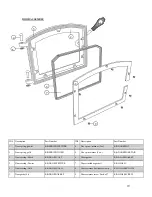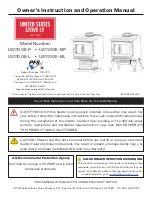
6
Section
2
– Mobile home installation
INSTALL AND USE IN ACCORDANCE WITH THE MANUFACTURER’S INSTALLATION
AND OPERATING INSTRUCTIONS ONLY. WHILE MOST ANYONE WITH BASIC
CARPENTRY SKILLS CAN SUCCESSFULLY AND SAFELY INSTALL THEIR KUMA WOOD
STOVE, IT IS HIGHLY RECOMMENDED THAT IT IS INSTALLED BY A QUALIFIED
PROFESSIONAL WHO IS PROPERLY TRAINED AND LICENSED–PREFERABLY AN NFI
CERTIFIED (NATIONAL FIREPLACE INSTITUE) EXPERT.
CAUTION:
The structural integrity of the mobile home floor, walls and ceiling/roof must be maintained.
Use additional bracing if required. Never cut a load bearing wall or engineered truss. Use elbows if
necessary to offset the pipe.
CAUTION: NEVER INSTALL A STOVE IN A SLEEPING ROOM.
STEP 1:Make sure you have the proper tools, materials, and stove components.
Tools:
1.
Reciprocating Saw
2.
Assorted Screwdrivers
3.
Measuring Tape
4.
Pencil
5.
Plumb Line
6.
Electric or Cordless Drill with assorted drill and driver bits
7.
Tin Shears
8.
Utility Knife
9.
Pliers
10.
Hammer
11.
Assorted Wrenches
Materials:
1.
Caulking to seal roof flashing and storm collar. High temperature silicone is recommended.
2.
Assorted heavy duty nails and screws.
3.
Short pieces of 2x4 or 2x6. Two pieces minimum 24” long.
4.
Copper wire (8 gauge) for grounding. Grounding “clamp” “terminal” or “lug” for attaching
ground wire at stove and mobile home frame.
Stove Components: (each component has installation instrucions included see sec. 8 for a complete
list of accessories)
1.
Stove body (K-WC)
2.
Pedestal or leg kit (KA-WCPED, KA-WLEGSTEEL, etc.)
3.
Door Kit (DOOR1CASTC, DOOR1GOLDC, etc.)
4.
Outside air kit (KA-OUTSIDEAIR)
5.
Optional Blower (KA-BLOWER1)
Determining the stove location:
When choosing a stove location there are a few things that should be considered.
1.
Try to choose a location that is centrally located in the house.
2.
Try to choose a location that will be easy to access from your wood storage area.
3.
Survey the roof area above and around the location of the chimney exit. Be sure there are no
dormers, roof valleys or any other roof irregularities that could cause difficulty when trying to set
and seal the roof flashing.







































